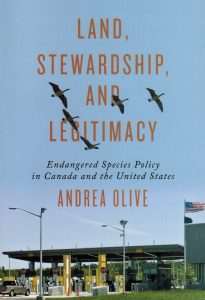The Lake Erie water snake can dive ten feet and swallow its prey head first. The snake is also endangered. Its favoured habitat is private lakefront property where landowners don’t enjoy snakes. “I see no reason why it should be protected,” one Pelee Island landowner told an interviewer. “If it were to go away, I don’t think anyone would miss it.”
This is the most vexing part of endangered species. Rare birds, fish and wildlife belong to all humanity, but the lakefronts and marshlands belong to ratepayers. As the Canadian Cattleman’s Association once told a Commons committee, “Number one: if a species at risk is viewed as a liability to a land manager, it will always be at risk.”
Prof. Andrea Olive of the University of Toronto examines this conflict in Land, Stewardship and Legitimacy. The results are intriguing. Olive discovers Canadians have a generally positive opinion of saving threatened species, but aren’t quite sure what to do about it; 61 percent of Saskatchewan residents agreed it would be unfair to ask landowners to pay the cost of protecting species that happen to nest, stalk or swim on their property.
“In Canada most land is privately managed,” writes Olive; “This is the consequence of history – of pioneers who were encouraged by government to settle two vast countries. The result today is that most biodiversity relies on private property, and on the people who own and manage it, for survival.”
Land, Stewardship and Legitimacy seeks solutions. Should we pay landowners not to kill water snakes? “Expensive,” Olive notes. Might shaming work? Maybe; the author recounts a 1982 study on the impact of anti-littering ads in Oklahoma City. Residents were twice as likely to feel guilty about littering, especially if the neighbours saw them doing it: “If outreach and education are able to inform enough people about the importance of biodiversity,” writes Olive, “then shaming people into conservation efforts might be a method to achieve changes in desired public behaviour.”
Land, Stewardship and Legitimacy recounts the fate of select endangered species including the Lake Erie snake; the Indiana brown bat; and Utah desert tortoise. Canada was an early signatory to the U.N. Convention On Biological Diversity in 1993, but Olive writes there’s no particular reason to feel superior.
More than 90 percent of southern Ontario’s Carolinian forests have been converted to farms or suburbs; British Columbia is home to almost two thousand threatened or endangered species; Alberta, Saskatchewan and Prince Edward Island have no actual, legally binding endangered species legislation.
So, if it is too much to offer tax breaks to save water snakes, and too mean to punish landowners who are indifferent, Prof. Oliver proposes something in the middle. Canadians must first be shown that species are at risk, and very simple steps might save creatures that thrived for generations: “That will take some work.”
By Holly Doan
Land, Stewardship and Legitimacy: Endangered Species Policy in Canada and the United States, by Andrea Olive; University of Toronto Press; ISBN 9781-4426-15748; 304 pages; $32.95






